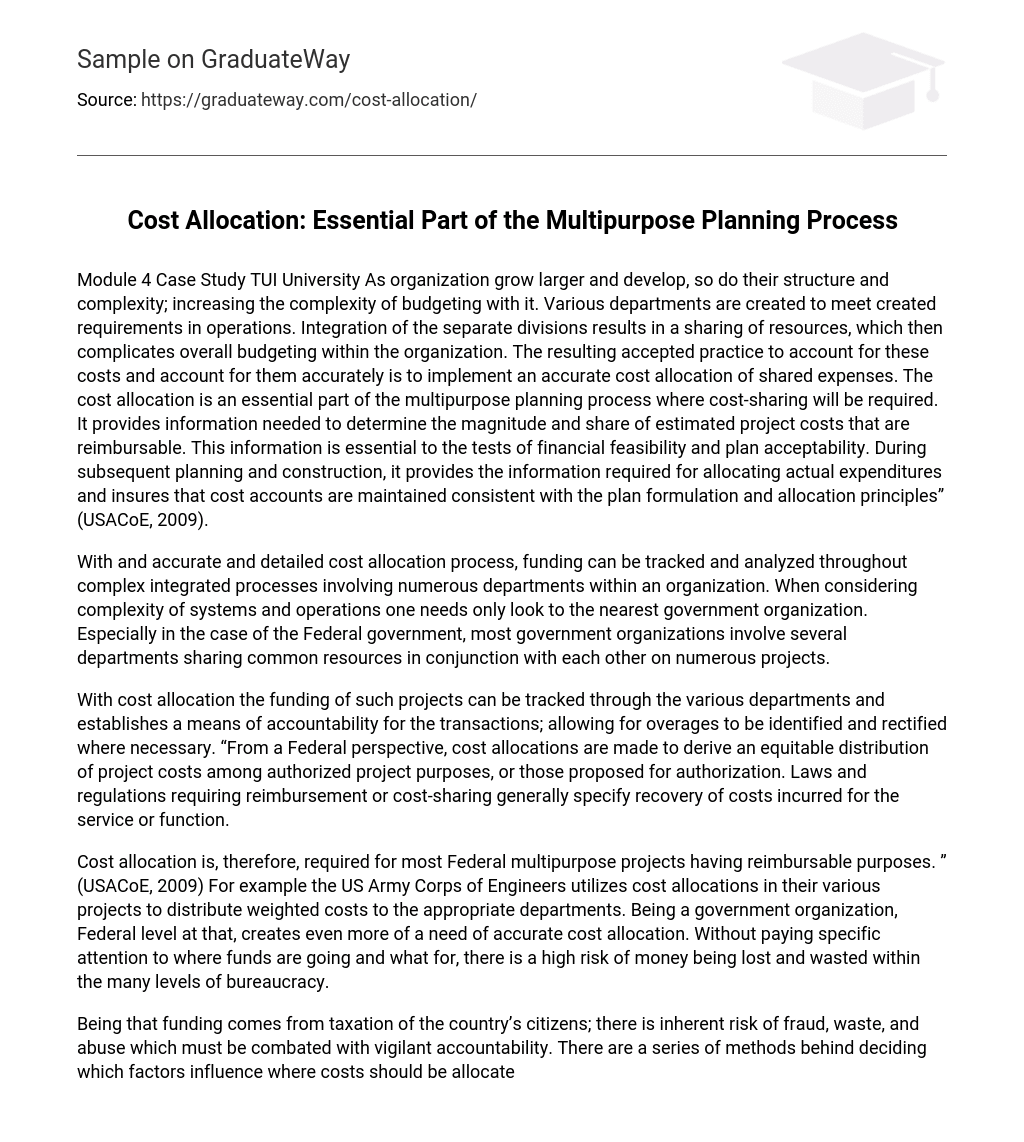Module 4 Case Study TUI University As organization grow larger and develop, so do their structure and complexity; increasing the complexity of budgeting with it. Various departments are created to meet created requirements in operations. Integration of the separate divisions results in a sharing of resources, which then complicates overall budgeting within the organization. The resulting accepted practice to account for these costs and account for them accurately is to implement an accurate cost allocation of shared expenses. The cost allocation is an essential part of the multipurpose planning process where cost-sharing will be required. It provides information needed to determine the magnitude and share of estimated project costs that are reimbursable. This information is essential to the tests of financial feasibility and plan acceptability. During subsequent planning and construction, it provides the information required for allocating actual expenditures and insures that cost accounts are maintained consistent with the plan formulation and allocation principles” (USACoE, 2009).
With and accurate and detailed cost allocation process, funding can be tracked and analyzed throughout complex integrated processes involving numerous departments within an organization. When considering complexity of systems and operations one needs only look to the nearest government organization. Especially in the case of the Federal government, most government organizations involve several departments sharing common resources in conjunction with each other on numerous projects.
With cost allocation the funding of such projects can be tracked through the various departments and establishes a means of accountability for the transactions; allowing for overages to be identified and rectified where necessary. “From a Federal perspective, cost allocations are made to derive an equitable distribution of project costs among authorized project purposes, or those proposed for authorization. Laws and regulations requiring reimbursement or cost-sharing generally specify recovery of costs incurred for the service or function.
Cost allocation is, therefore, required for most Federal multipurpose projects having reimbursable purposes. ” (USACoE, 2009) For example the US Army Corps of Engineers utilizes cost allocations in their various projects to distribute weighted costs to the appropriate departments. Being a government organization, Federal level at that, creates even more of a need of accurate cost allocation. Without paying specific attention to where funds are going and what for, there is a high risk of money being lost and wasted within the many levels of bureaucracy.
Being that funding comes from taxation of the country’s citizens; there is inherent risk of fraud, waste, and abuse which must be combated with vigilant accountability. There are a series of methods behind deciding which factors influence where costs should be allocated. Many organizations default to very basic and straightforward set of characteristics which determine its final allocation. Upon reviewing the City of Seattle’s allocations and factors determining said allocations, it is apparent they utilize the generally accepted straight forward approach. 1. Information—It shall provide the appropriate accounting information required by management to account for state agency programs as required by state law. In providing the required information, management shall give appropriate consideration to the cost of obtaining and providing the information in relation to the benefits to be derived from the information. 2. Timeliness—It must produce program cost data on a timely basis. 3. Consistency—The cost identification and distribution methods selected will be applied consistently from period to period. . Accuracy-The information provided shall be as accurate as possible. 5. Auditability—Program costs must be fully auditable; i. e. , working papers must be retained showing program cost identification, accumulation, and distribution methods” (SAM, 2009). When reviewing Seattle’s individual factors of allocation, at least one of the stated characteristics could be applied in justification. Unfortunately the complexity of the system does not allow for a “blanket” approach to allocation.
Each cost is unique and must be judged independently. Just as with the US Army Corps of Engineers, the City of Seattle is a government entity utilizing the cost allocation principle. Again, the complexity of the system and the risk of abuse and waste warrants the system just as much if not more than that of the private industry. If a company loses track of their expenditures they hurt themselves, the government hurts its citizens in the same scenario.
To further examine the complexity of the government bureaucracy and the level of shared funding, one needs only look into the Department of Human Services to see the inter-relations between social programs, illustrating the increased need for accurate cost allocation to ensure funding is being accounted for properly. To ensure this across the board the Department of Human Services has created an entire division dedicated to just that. “The Division of Cost Allocation (DCA) provides negotiation services for indirect cost rate proposals and cost allocation plans.
For more than 50 years, DCA has reviewed cost allocation methods and practices of entities that receive Federal funds, helping to ensure that indirect costs paid by the Federal Government are fair, equitable, and in accordance with Federal regulations” (DoHaHS, 2009). With an entire department looking at solely holding other departments accountable for their spending, while providing a valuable tool in analyzing the common funding used in various key programs shared by hospitals, colleges, and non-profit organizations. California’s Department of Technology Services (DTS), Internal Service Fund (ISF), bills numerous Federal programs for IT services used to perform federally funded State programs. Included are large Federal grants for programs such as Medicaid and ACF’s Temporary Assistance for Needy Families, and FNS Food Stamp and Special Supplemental Nutrition for Women, Infants and Children (WIC)“ (DoHaHS, 2009). By dedicating an entire staff to monitor the complex activities, proper spending habits can be ensured in a rather volatile environment.
The basic theme of cost allocation is the fact it is an efficient tool for tracking shared funds in complex organizations. By allocating costs between shared programs between departments a high level of accountability can be maintained; limiting the possibility for waste and loss within the organization. Bibliography US Army Corps of Engineers (USACoE).





